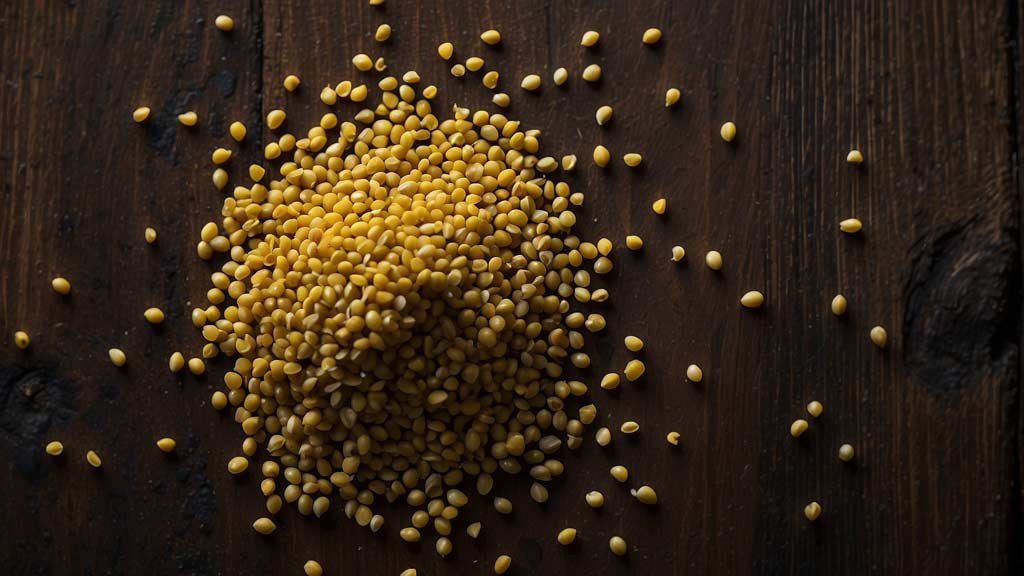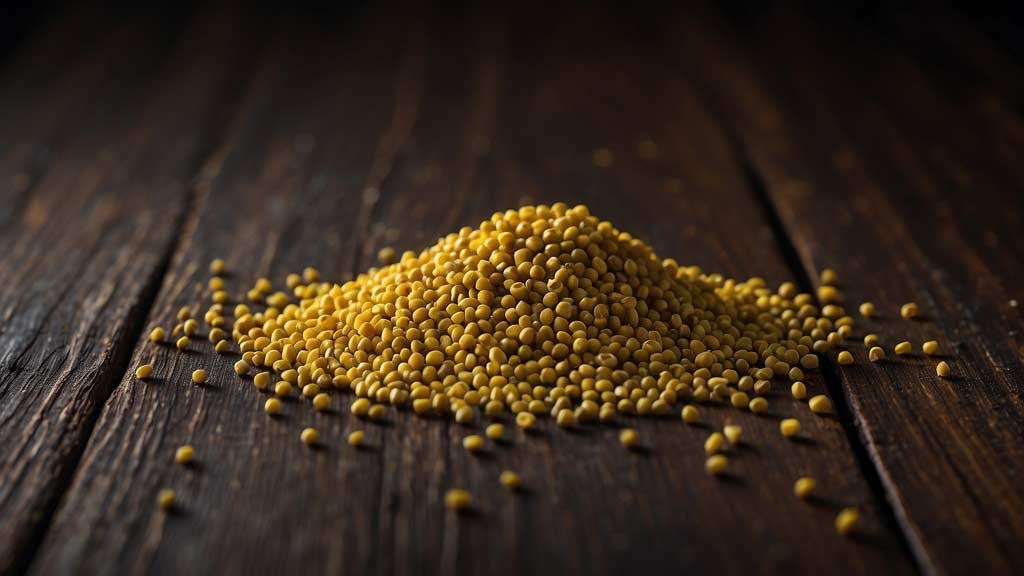A Seed with a Bite
Crack open a jar of mustard and you’re immediately hit with that sharp, nose-tingling aroma. That’s mustard seed at work—tiny, round, and unassuming, but packed with fire. These seeds have been in kitchens and medicine chests for centuries, scattered across cultures from ancient Rome to rural India. People didn’t just grind them into sauces; they pressed them, poulticed them, brewed them into teas. Mustard seed isn’t a single-note spice. It’s an old-world remedy hiding in plain sight, one that stirs circulation, wakes digestion, and even warms aching joints.
Table of Contents
The Many Faces of Mustard
Mustard comes in a few varieties. You’ve got:
- White or yellow mustard (Sinapis alba): Milder, often used in classic yellow mustard condiments.
- Brown mustard (Brassica juncea): Pungent, common in Indian cooking.
- Black mustard (Brassica nigra): The most intense and often favored in traditional remedies.
Each one carries glucosinolates—sulfur compounds that transform into allyl isothiocyanate when crushed or chewed. That’s the fiery compound responsible for mustard’s trademark bite. But that bite isn’t just sensory theater. It’s a physiological spark that influences circulation, metabolism, and digestion.
Mustard and Blood Flow
One of the most consistent folk uses of mustard seed has been as a circulatory stimulant. People noticed long ago that when mustard paste was applied to the skin, it pulled blood to the surface, turning it pink or even red. That’s vasodilation in action—capillaries opening up, blood moving faster.
This isn’t only about a rosy flush. Improved circulation can mean:
- Warming cold extremities in winter months.
- Loosening stiff joints by getting more blood into the area.
- Soothing muscular tension after hard work.
Of course, anyone who has tried a mustard foot bath knows the sensation: first a creeping warmth, then a tingling, almost prickly heat that seeps upward. It’s not subtle. The skin feels alive, humming. Some old European households swore by mustard baths for colds, the theory being that drawing blood to the skin “pulled congestion away” from the lungs. Whether you buy that logic or not, the relief people felt was very real.
Digestion: Fire in the Belly
Mustard seed doesn’t just wake up the skin; it wakes up the gut. That same pungent kick stimulates saliva and gastric juices. For sluggish digestion, a pinch of ground mustard can work like a nudge to get things moving. It’s not unlike how bitter herbs prepare the stomach—mustard just does it with heat instead of bitterness.
Traditional systems leaned into this:
- Indian cooks often added mustard seeds to oil, letting them pop and release their volatile compounds before vegetables hit the pan. That wasn’t just flavor—it was digestion support.
- Some European traditions involved swallowing a few whole mustard seeds with water as a home remedy for constipation or indigestion.
There’s a fine balance, though. Too much raw mustard can irritate. It’s a reminder: the line between medicine and poison is thin, and mustard seed walks it.
Mustard Poultices: Old Remedies with Bite
Poultices made from mustard seed meal were once standard household treatments. The recipe was simple: grind seeds, mix with warm water, spread on cloth, and apply. Within minutes, the skin tingled, burned, flushed. That burning was both friend and foe. Leave it on too long and blisters formed. Remove it in time, and you got relief:
- Chest poultices were used for bronchitis, pneumonia, or deep coughs. The heat felt like it loosened phlegm, gave the chest room to breathe.
- Joint poultices helped arthritis or rheumatism by drawing blood to the area, easing stiffness.
- Abdominal poultices sometimes treated colic or digestive sluggishness.
I remember my grandmother telling me how her mother slapped mustard plasters onto her chest during long winter fevers. “It burned like the devil,” she said, “but I could breathe after.” These were not gentle remedies. They demanded respect.
Mustard Seed in Folk and Religious Traditions
Beyond medicine and food, mustard seed carries symbolic weight. In the Christian tradition, the mustard seed represents faith: small yet capable of great things. Ayurveda weaves mustard oil and seeds into daily life, not just as medicine but for massage, cooking, and ritual. In old Greek and Roman practices, mustard was planted as a sign of fertility and strength.
It’s fascinating how such a tiny seed became both metaphor and medicine across cultures. Maybe it’s because mustard, despite its size, always makes itself known—on the tongue, on the skin, in the belly.

The Chemistry Behind the Heat
Mustard’s fire comes from a neat trick of plant chemistry. The seeds themselves are bland until broken. Inside, enzymes (myrosinase) meet glucosinolates, forming isothiocyanates. This reaction is mustard’s defense mechanism—biting predators get a mouthful of chemical warfare. Humans, of course, turned that to our advantage.
These compounds aren’t just irritants. Modern studies suggest they may have antimicrobial, antifungal, and even anticancer properties. Isothiocyanates seem to help neutralize carcinogens in lab models. That doesn’t mean mustard seed is a miracle cure, but it does underline why people kept it around.
Internal Use: A Pinch, Not a Handful
You’ll sometimes hear about people swallowing whole mustard seeds for various ailments. The reasoning was that seeds would stimulate digestion without releasing too much of their pungent oil all at once. Still, moderation is key. Mustard seed in food is safe, even beneficial. But concentrated doses—especially of the black variety—can irritate the stomach lining, provoke nausea, or worse.
The sensible approach? Use mustard seed as spice, condiment, occasional remedy—not daily capsules in high amounts. A teaspoon in cooking, fine. A tablespoon of raw ground seed swallowed outright, not so much.
External Use: Respect the Heat
The poultice tradition lives on, though with caution. Modern herbalists sometimes suggest mustard plasters for deep chest congestion, but always with warnings: never leave on longer than 15 minutes, never apply directly to sensitive or broken skin, and always dilute with flour or another base.
Even mustard baths—where ground seed or mustard powder is added to hot water—carry the same caveat. They’re warming, invigorating, but they can also irritate if overdone.
Culinary and Medicinal Overlap
It’s worth remembering that mustard seed’s medicinal uses aren’t separate from its culinary ones. When you eat a curry cooked with popping brown mustard seeds, you’re not just enjoying flavor—you’re giving your digestion a little push. When you slather mustard on a sausage, you’re not only tasting sharpness; you’re also stimulating saliva and enzyme production.
Food as medicine doesn’t always have to be mystical or complicated. Sometimes it’s as ordinary as what’s on your sandwich.
Mustard in the Garden
Growing mustard isn’t difficult. The plants thrive quickly, with leafy greens that can be eaten while young and seeds harvested later. Farmers often use mustard as a cover crop because its glucosinolates help suppress soil pathogens. That’s another layer of usefulness—mustard not only feeds us, it heals the soil.
There’s something beautiful about that cycle: a fiery plant that enlivens both land and body.
Risks and Precautions
No herb is without its shadow. With mustard seed, the risks include:
- Skin irritation: Blisters if poultices are left too long.
- Gastrointestinal upset: Especially in large, raw doses.
- Thyroid concerns: Like other brassicas, mustard contains goitrogens, which may affect thyroid function if eaten in very large amounts raw.
Pregnant women, young children, and those with sensitive skin should avoid strong mustard poultices. And anyone with ulcers or gastrointestinal inflammation should be cautious with internal use.
Why Mustard Seed Endures
Why has mustard seed stuck around so long in kitchens and folk medicine cabinets? Maybe because it’s cheap, accessible, and effective in small ways that add up. It doesn’t pretend to be gentle—it stings, burns, wakes you up. It demands moderation and respect.
When I think of mustard seed, I think of how something so small can cut through heaviness. A greasy meal, a congested chest, a cold winter evening—it has an answer for all of these. Not a perfect one, not without risks, but a living tradition that still makes sense.
Article Sources
At AncientHerbsWisdom, our content relies on reputable sources, including peer-reviewed studies, to substantiate the information presented in our articles. Our primary objective is to ensure our content is thoroughly fact-checked, maintaining a commitment to accuracy, reliability, and trustworthiness.
- Aggarwal, B. B., & Ichikawa, H. (2005). Molecular targets and anticancer potential of indole-3-carbinol and its derivatives. Cell Cycle, 4(9), 1201–1215. https://doi.org/10.4161/cc.4.9.1993
- Bhandari, S. R., Jo, J. S., & Lee, J. G. (2015). Comparison of glucosinolate profiles in different tissues of nine brassica crops. Molecules, 20(9), 15827–15841. https://doi.org/10.3390/molecules200915827
- Department of Agriculture, Agricultural Research Service. (2020). Mustard seed, ground. FoodData Central. Retrieved from https://fdc.nal.usda.gov
- Fritz, H., Seely, D., Flower, G., Skidmore, B., Fernandes, R., Vadeboncoeur, S., Kennedy, D. A., Cooley, K., Wong, R., & Seely, A. J. (2014). Soy, red clover, and isoflavones and breast cancer: A systematic review. PLoS ONE, 8(11), e81968. https://doi.org/10.1371/journal.pone.0081968
- Gore, R. D., & Deshpande, S. (2019). Role of medicinal plants in traditional health care practices: Mustard seed (Brassica species). Journal of Pharmacognosy and Phytochemistry, 8(3), 1112–1116. https://www.phytojournal.com
- Hayes, J. D., & Kelleher, M. O. (2016). The cancer chemopreventive actions of phytochemicals derived from glucosinolates. European Journal of Nutrition, 55(2), 311–331. https://doi.org/10.1007/s00394-015-0929-5
- Kumar, S., & Pandey, A. K. (2015). Chemistry and biological activities of flavonoids: An overview. The Scientific World Journal, 2013, 162750. https://doi.org/10.1155/2013/162750
- Mukherjee, P. K., & Wahile, A. (2006). Integrated approaches towards drug development from Ayurveda and other Indian system of medicines. Journal of Ethnopharmacology, 103(1), 25–35. https://doi.org/10.1016/j.jep.2005.09.024
- National Center for Complementary and Integrative Health. (2020). Herbs at a glance: Mustard seed. National Institutes of Health. Retrieved from https://www.nccih.nih.gov
- Sharma, R., & Sharma, P. (2018). Traditional and medicinal uses of mustard seed. International Journal of Herbal Medicine, 6(6), 111–115. https://www.florajournal.com




